Excitement rushes through my body when I see trout or grayling rising on the river; even after 40 years of dry fly fishing.
I steady myself as my heart starts pumping.
Then, it’s down to the business of answering the list of dry fly fishing questions that are racing through my mind:
- How big is the fish?
- What does its rise form tell me?
- What fly is it feeding on?
- How to cover the fish without spooking it?
To become one of the anglers who catch 80% of the trout and grayling you have to…
STOP and consider those questions before casting your dry fly.
This dry fly fishing guide explains how to answer the aforementioned questions, with a special reference to dry fly fishing on the Welsh Dee. I’ve also included details of the basic tackle requirements for a beginner to start dry fly fishing.
How big is the rising trout or grayling?
Well, where fishing is concerned I would be lying if I said…
“Size doesn’t matter”
I certainly want to catch a fish of a lifetime, a Monster trout or grayling.
Don’t you?
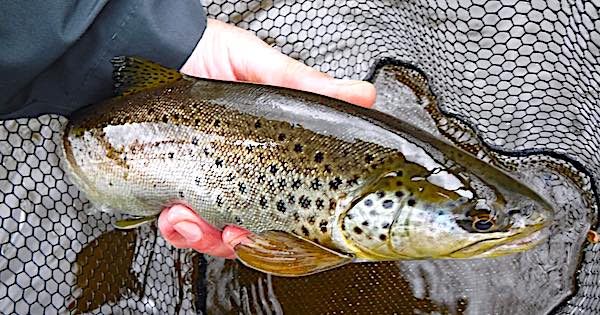
Apart from the above flippant comment, the size of the fish is important because it helps you decide on an approach to catching it.
Small fish are less wary, and you’ll probably be able to cover them more than once with your dry fly before it’s spooked.
On the other hand for large trout, you’re only likely to get one cast to it. So you have to make it count.
If the light is favorable with polarising sunglasses you might be able to see how big the fish is.
However, in poor light or you can’t get into a suitable viewing position without spooking the fish, your only option is to infer its size from its rise form. So, how is that done…
What does the rise form tell you?
The way a trout moves in the water when it’s feeding can tell you several things:
- Its size,
- and feeding patterns.
Small trout often display an excited, splashy rise form…
“more commotion equals smaller fish“
Large trout, on the other hand, often gently slurp the fly from the surface.
After the slurp, bubbles often appear on the surface; typically, more bubbles equals bigger fish.
Look for the fish just poking their nose through the surface and inhaling the fly by cavitation.
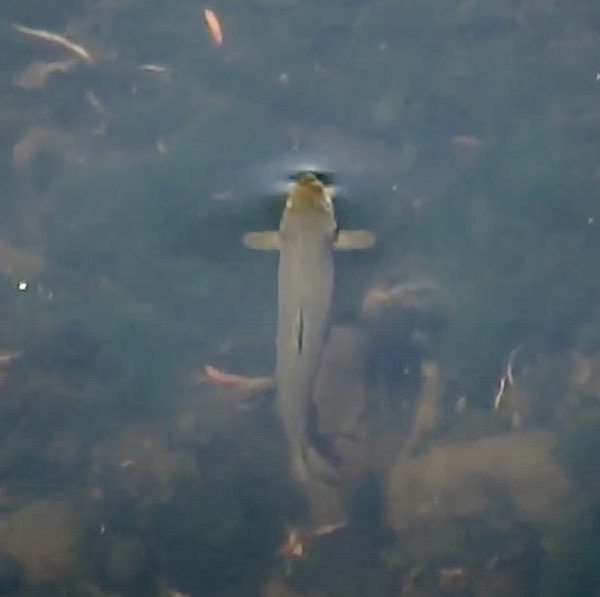
Trout sipping flies off the surface often go unnoticed when you don’t take time to watch the parts of the river where you’d expect a big trout to reside.
When trout and grayling are feeding on emerging flies under the surface you often just see the back of the fish disturbed or swirl at the surface. Also, there is an absence of bubbles on the surface.
On the Welsh Dee, if you see this back-breaking rise form in the tails of a pool, it is usually a grayling, which can be quite large.
Now you should have an idea of:
- the size of the trout or grayling, and
- if it’s taking flies as they emerge or on the surface.
The next step in the process is to determine what fly the fish is feeding on.
Dry fly selection for trout & grayling:
In this important step, focus on what flies are hatching (coming off the water). Rather than the flies buzzing around you because the latter might be a result of a previous hatch, and the fish are now feeding on something else.
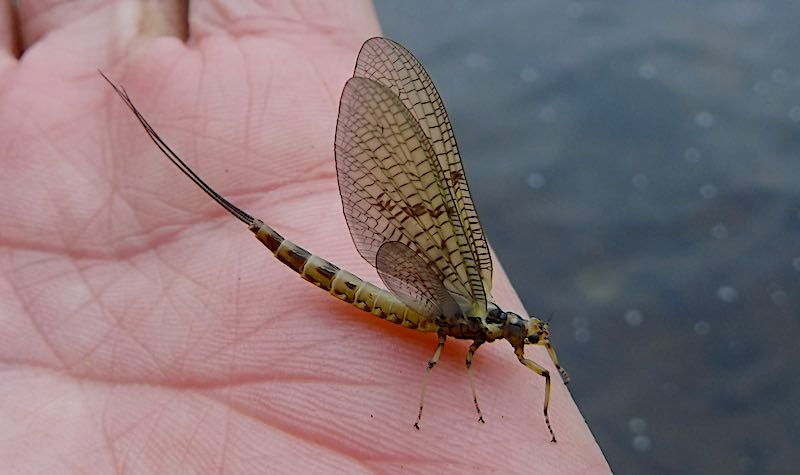
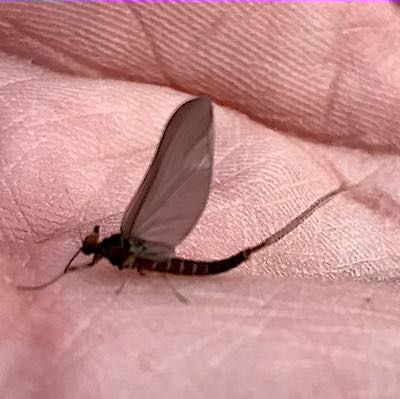
If you can identify the fly, move on to selecting a suitable dry fly from your fly box.
Sometimes identification is impossible, even when using a pair of binoculars to get a closer look.
This is where knowledge of the flies that might be hatching on the river becomes invaluable.
Fortunately, as a starting point, you only need basic knowledge of the most common fly species you’re likely to see on UK rivers.
Flies for river fishing: A mobile-friendly guide that helps in matching the hatch
Armed with this knowledge it’s a matter of selecting a suitable fly from your box and seeing if tempts the fish.
If there’s no response after a few casts it’s now a trial-and-error process until…
“BINGO – Fish On”
I must add a word of caution on the trial and error process:
If you’ve spotted a big fish don’t practice this trial-and-error approach on it, because you will only have one or two casts before it spooked.
A wiser approach is to leave the big fish alone. Instead, move on and target smaller fish, those with splash rise forms, with the trial and error approach for fly selection.
When you’ve identified a fly that catches the small fish, go back to target the larger fish with it. Often the large fish will be taking the same flies.
How to present the dry fly:
When stalking a rising trout or grayling, the next challenge is presenting the dry fly to have the best chance of catching it.
The first step is to decide on a position where you can make a good cast without putting the fly line over the fish and spooking it. Usually, this will be downstream of the rising fish.
Take your time sneaking up to the casting position.
Once there, wait patiently until you’ve seen it rise a couple of times, before making the cast.
Aim to get the fly to land about 1-2 ft above the rise and slightly over to the near side of the fish. If you cast directly at the rise, the fly will land behind where the fish is lying and will be missed because it is watching upstream for its dinner.
It’s important the first cast to the trout is your best and the fly drifts drag-free towards it. Since with every additional cast, the likelihood of spooking it increases dramatically.
When everything aligns, the fly will be engulfed, and when you strike…
the fish takes off and you’re in PLAY
What if your cast was perfect but the trout failed to take the fly?
More often than not it’s because the fly dragged on the surface, it might only be slight but that can be enough to put the fish off taking your fly.
In this case, you need to make a cast that lays down some slack-line to eliminate the drag, e.g. the reach cast…
The following video shows how to catch a wild brown trout using the dry fly fishing Reach Cast…
If drag is not the problem, other solutions to try, include:
- switching to a longer, finer tippet,
- using a smaller fly pattern
- changing to an emerger pattern that floats just in or below the surface
When I’m having trouble seeing the fly, because it’s small or there is a ripple on the water, I often switch to fishing a double dry set-up.
The double dry set-up involves fishing the small fly on a 2ft dropper, trailing behind a large sight fly.
One of my favourite double dry set-ups is a size 18 Griffith’s Gant paired with a size 12 Elk Hair Caddis, which is very effective on the Welsh Dee and River Ribble.
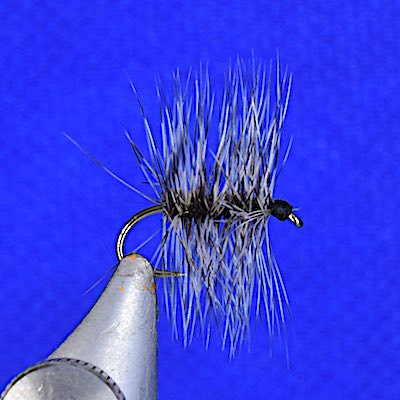
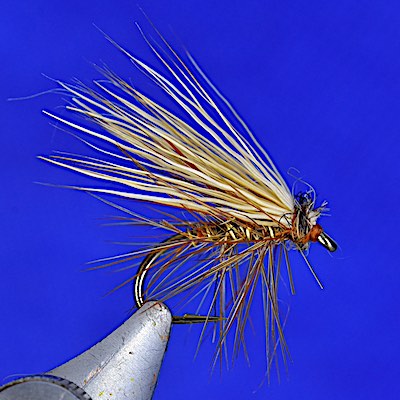
Sometimes you are faced with a situation where an upstream cast to the rising fish isn’t possible and your only approach is a downstream cast.
When casting downstream you need to introduce slack in the line just before it lands on the water, so that the fly will drift drag-free to the fish. If the fish doesn’t take the fly, you need to recast before the line is fully extended.
The downstream casting method I found easy is to ‘check back’ the line before it lands on the water. You could also make a slack-line cast by wiggling the rod just before the line lands.
When it all comes together you can have a spectacular and exciting day dry fly fishing for crafty trout and grayling. However, if it doesn’t you can always turn to wet fly fishing or nymphing and hopefully net a fish of two.
My Top 7 flies for dry fly fishing on the Welsh Dee:
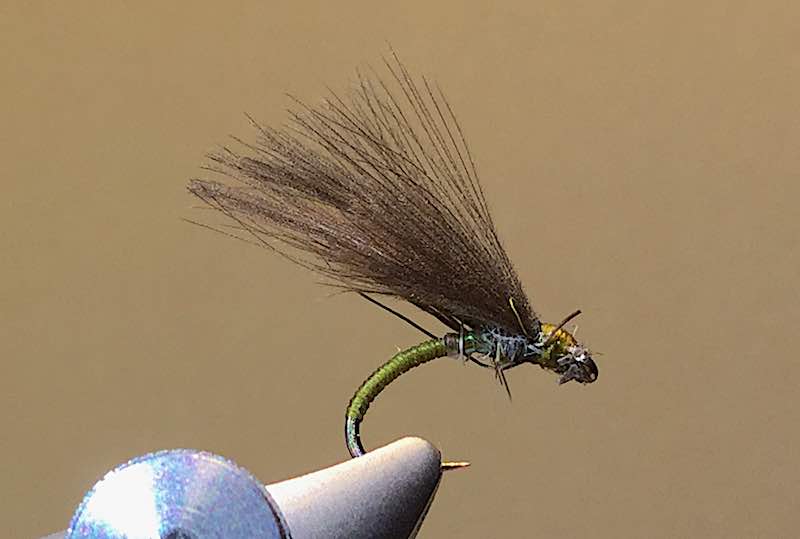
CDC Olive Emerger
- Hook: Kamasan B170 #14
- Thread: Olive UNI 8/0
- Body: Hare’s Ear dubbing
- Underwing: 4 Elk hair fibres
- Overwing: 3 CDC feathers
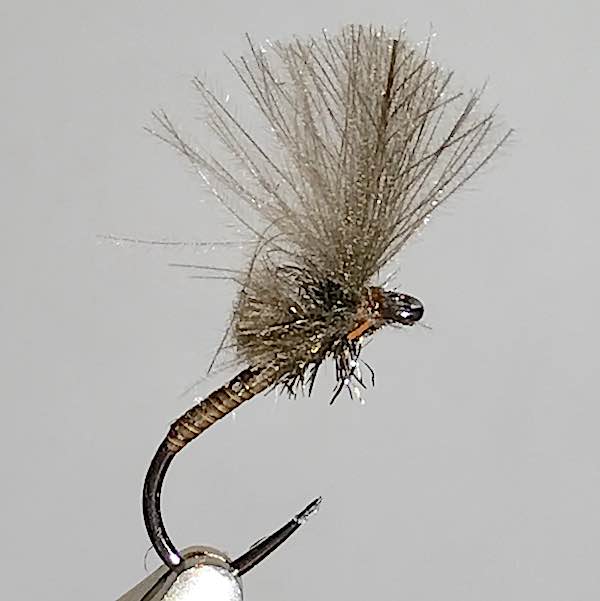
Quill Emerger
- Hook: HENDS BL354 #16 & 18
- Thread: Tan UNI-Thread 8/0
- Body: Peacock quill
- Thorac. Peacock Herl
- Wing: 3 CDC feathers
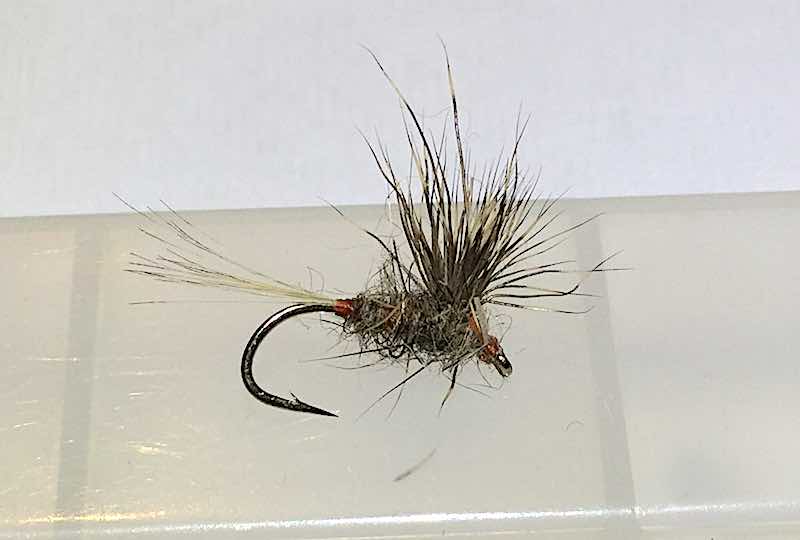
Hare’s Ear Paradun
- Kamasan KB170 (#14)
- Tan UNI-thread 8/0
- Tail – Grizzle cock fibres
- Body – Hare’s ear dubbing
- Wing – Elk’s hair
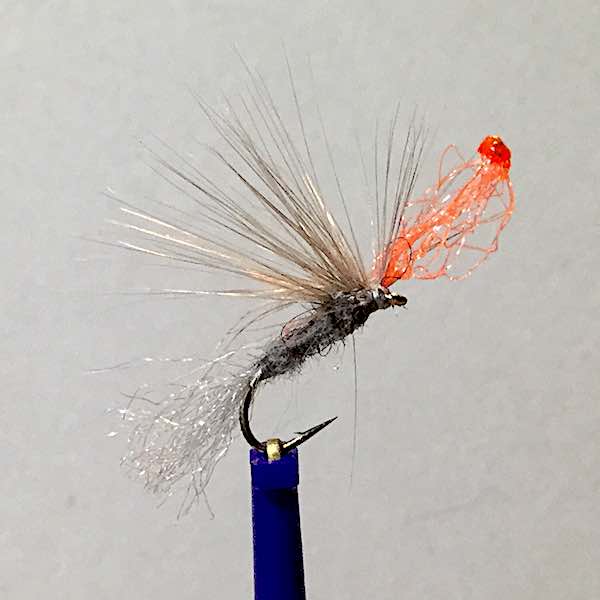
Crumpled Iron Blue emerger
- Hook: Kamasan B170 #16 & 18
- Thread: Grey UNI-Thread 8/0
- Tail: Grey Anton yarn
- Body: Mole fur
- Indicator: Orange Anton
- Hackle: Crumpled Iron Blue cock
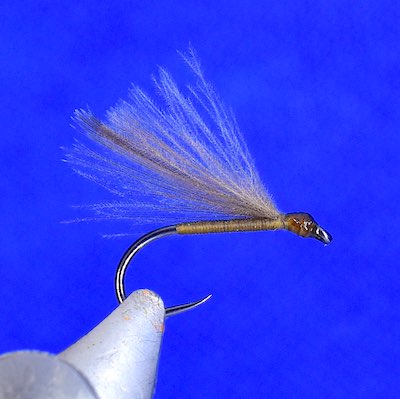
F-fly in various colours
- Hook: HENDS BL354 #16 & 18
- Thread: Olive UNI 8/0
- Body: Olive thread dubbing
- Wing: 3 CDC feathers
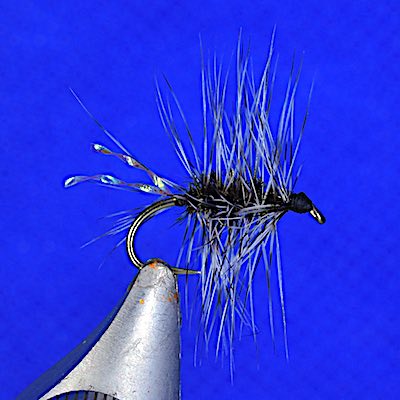
Sparkle Griffiths Gnat
- Hook: Kamasan B170 #18
- Thread: Black UNI 8/0
- Tail: Two strands of crystal flash
- Body: Peacock herl
- Hackle: palmered Grizzle cock
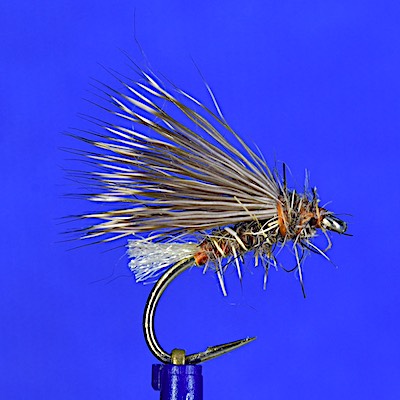
Elk hair caddis (cream tag)
- Hook: Kamasan B170 #14 & 12
- Thread: Burnt orange UNI 8/0
- Tail: Cream Atron
- Body: Fox squirrel dubbing
- Rib: Gold wire
- Wing: Natural Elk hair
Dry fly fishing tackle – basic list for beginners:
Fly fishing rod:
I use a 9ft #5 weight rod with a mid-tip action for all my dry fly fishing, on small to large rivers (up to 50ft wide). However, I would quite happily use a 9ft fly rod in weights from #3 to #6.
Fly fishing Reel:
For dry fly fishing, I would recommend a small, lightweight reel matched to the fly line weight. There are plenty of reasonably priced reels on the market that will do. Look for one that has a smooth easy to adjust drag-system.
Dry fly line:
At the moment for my dry fly fishing, I’m using an Airflo SuperDri WF5. Most branded lines are of good quality, therefore, if you are starting out pick an inexpensive one.
Leader & Tippet
Most of the time for dry fly fishing I use a 9ft copolymer or monofilament 5X tapered leader and add 3ft of 3lb copolymer. On windy days switch the leader from a 9ft to a 7ft 5X tapered leader.
Dry Fly fishing accessories:
- A landing net with a magnet release clipped on the back of your jacket
- A bottle of dry fly floatant – I use Gink
- Line degreaser – I use Fulling Mill Fuller’s Mud
- Something to dry the fly – I use a dry microfiber cloth
Also if you are interested in dry fly fishing on the Welsh Dee there is some excellent Day Ticket water at Llangollen.
I hope you have found this post on dry fly fishing for crafty trout and grayling very interesting.
PS. It would be great to hear your thoughts on this dry fly fishing post and please share it with your friends.
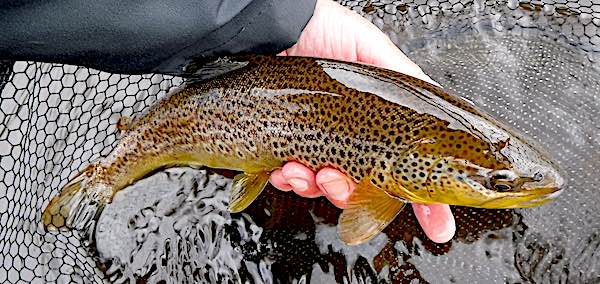
Thanks Andrew this is a really useful blog. It is strange how some of the patterns don’t look much like the actual fly.
At present I am using a 5 wt setup, however, am thinking of also using a 3 weight setup. My 10..5 ft 3# nymph rod will break down to a 9 ft dry fly rod. I know it will be of little use on windy days, but hopefully will give a softer presentation
Hi Tim,
Great to hear you enjoyed the blog. When trout and grayling are looking up through the water at a fly they have a completely different view compared to when we view it. Therefore, I think it’s just a matter of matching the size, shape and overall colour of the fly.
Your 3# rod should be fine for the Dee, especially for close range dry fly fishing.
Cheers, Andrew
One of my fixations during lockdown is the arrangement of my fly box and boxes (I’ve got past the tying stage). I have one small box (9x12cm) for dries and emergers. Then a Whiteley compartment box containing nymphs, shrimps and large hairy bugs. I don’t have a specifically wet fly box. Perhaps I should. Then a very small aluminium box for a few mayflies for when I fish the Avon nr Salisbury. That’s basically it. That’s what I carry in my jacket. What are the principles that you adopt in arranging your boxes? Have you any photos of your river boxes; what do you carry when on the Dee? Thanks. Richard
Hi Richard,
I normally carry four slim boxes organised for my go-to wet, dry, nymphs and spiders, which I have in my pocket. Also, a couple of back-up boxes with flies for difficult conditions. I will email you a photo shortly.
Cheers, Andrew
Thanks for the fly-box advice Andrew!
Hi Andrew , really enjoyed that article and I am sure it will improve my catch rate., I have watched a few of your videos when you are fishing on the Dee and you have and are using two rods , where/how do you carry the spare rod when in the water fishing ?
Hi Alan,
If I think I’m going to have to change approach while wading up through a pool I will stick my spare rod in the top of my chest waders and push it to my left side because I’m righthanded. Otherwise, I just leave it in a safe place on the bank.
I hope this helps, Andrew
Lovely article,full of very useful information and conveys the passion of the “dry fly” ,that and”emerger” fishing to me is the icing on the cake! you cannot beat seeing the take , and the expectation is second to none!
Hi Robert,
I’m pleased that you enjoyed the article.
Cheers, Andrew
Always a pleasure to read your reports, thank you…
That great to hear.
Cheers, Andrew
Interesting and especially great for me coming from South Africa!! Great detail, many thanks Andrew
Hi Andrew,
Very pleased to hear you are enjoying the blog post.
Cheers, Andrew
Good afternoon Andrew and thanks, once again, for a most entertaining and informative article. As i started reading, my mind regressed to my youth when around age 10, I couldn’t wait to pick up my “Mr Crabtree goes fishing” book and would refer to it, along the the series of “How to catch them” books .. Trout, Sea Trout, Salmon, and many species of coarse fish, and they were my fishing “Bibles” in the 1950s !! Your articles are the greatly updated and expanded version of these books and a tremendous source of knowledge from the beginner to the experienced angler including fly tying. Over 65 years have elapsed since I started fly fishing but you continue to provide us with something new. Long may you carry on producing these for many years to come. Thanks from me and all your readers. Tight Lines for the grayling season.
Hi Barrie,
It’s great to hear you are enjoying the articles and they are taking you back to your youth.
Thanks for the comments, Andrew
Dear Andrew, what a useful and informative blog. In the past four years I and five friends always have a week fishing the Dee based at Dolgadfa. Last year I had a good few sessions mostly catching greyling, whilst my friends blanked entirely (bar one trout to a black gnat).
They were complaining about the absence of fish on the sections of the river at Llandderfel and Dolgadfa which had worked for me. I also fished the beat below the Bala outflow successfully but, by then, they were all in a funk having ensconced themselves in the Bryntirion Inn and (Heaven forbid!!) even resorted to the golf course. Intent upon raising fresh hope I stumbled across your blog researching other beats on their behalf.
However, I was intrigued to note my techniques matched your advice, fishing small (never over 16, usually 18, sometimes 20), usually black and griffiths gnats but also olives, duns with tups indispensable as the Caenis imitation, very much your recommendations, at the tail of pools in the late evening, etc. I had even equipped myself for Euro nymphing through the day and this, too, proved successful. In previous years one friend, a skilled Yorkshire based fisherman, had great success with his own March Brown to which he has resolutely remained fixated (the odd bout of klink and dink excepted), but I think a size 12 (maybe 14) rather startled the fish last year.
Consequently, as they won’t take my advice, I have advised them all to read your masterful blog and take yours!
Meanwhile, being profoundly impressed, I’ve subscribed. There’s always something new to learn. Thanks very much for your effort and all the best for 2022.
Hi John,
It is interesting to hear about your experience of fishing the Welsh Dee. There are plenty of grayling distributed throughout the river and once you work out what flies are being taken you will have a great day fishing. I hope your friends modify their approach and start catching some lovely fish.
Thanks for subscribing to the blog and I hope it continues to help. Cheers, Andrew
Very interesting post Andrew as always, one comment I’ll make is when casting upstream to the fish with a dry fly, you say to try and cast one to two feet above the rise.
An experienced angler once told me that often when a fish rises in the river it has some times drifted down stream for a couple of feet from its lie as it inspects the fly before taking it.
So in this case it’s better to try and cast at least four to five feet above the rise as the fish may have moved at least two feet back upstream again.
I think this applies more to larger fish that youngsters, but I’ve always adopted this method and it seems to work.
Hi Steven,
Thanks for your useful comments, which I agree with in part. In steady flow where the fish have time to inspect the flies, I agree that 4 to 5 ft above the rise is a better approach. However, when fishing fast-flowing rivers trout and grayling have little time to follow the fly out of their lie downriver. So 1 to 2 ft often works fine and minimizes the chance of getting drag on the fly.
I will try and update the post to outline these points.
Thanks, Andrew
I find all of your guides very helpful for fishing the Welsh Dee at Bangor where I am a new member and bring me success on my last visit.
Hi Paul,
Great to hear that my posts are helping you catch some fish. Where have you been fishing at BoD?
Tight lines, Andrew
Very informative a lot to digest keep it coming. Great stuff
Hi Tony,
Pleased to hear that you enjoyed the post.
Thanks, Andrew
I was fishing Taylors Pool downstream yesterday ( last day of June ).Flies used were spider patterns as reccommended by Louis Noble in The Beat magazine. Fishing across and downstream had some hard takes. One nice Grayling and a few very small Brownies. Wind was quite a problem during the day . Finished at about 5 pm .but wondering to start at 5pm and fish till dusk ?
Hi Colin,
It’s worth staying past 5 pm on the Welsh Dee because you often experience a mad hour of fishing at dusk. There is also a good chance of catching a sea trout on spiders, especially in July and August.
I hope this helps, Andrew
Always a pleasure to read your tweets..thank you.
Great to hear you enjoyed it and thanks for the feedback.
Always a pleasure to watch your videos and read your posts. Some great action shots and how to posts on dressings. Where is the river Earmont? Not heard of it before but looks a lovely piece of water. Keep up the good work and tight lines. Iain.
The River Eamont is in Cumbria and it runs through Penrith. It’s a great river and holds some very large brown trout but they are not easy to catch.
Tight lines, Andrew